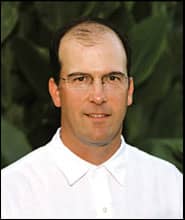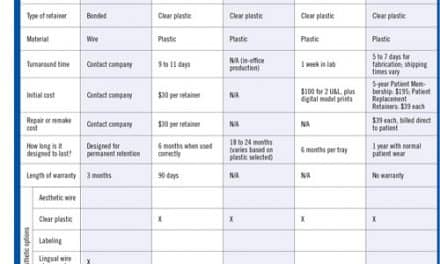by John D. Wise, DDS

The program leaders at the Texas Mission of Mercy (TMOM) don’t let us orthodontists do too much. They try to keep the needles and sharp instruments out of our hands. Imagine my surprise, then, when I was asked to head up the removable prosthesis department at the Laredo, Tex, TMOM in 2007. I think my experience grinding on plastic retainers and delivering orthodontic appliances swayed them over. Wow! I was in charge of an entire department at one of the most anticipated TMOMs in the Texas Dental Association’s history. (Later I found out that I was the only possible choice, since no one else wanted to do it.)
On the Thursday before the event, I was asked to set up the lab area. Like any good planner, I wanted to see what my assets and challenges were. I was shown the lab equipment, consisting of a Dremel from Home Depot, a few alginate and stone mixing bowls, two wax spatulas, different acrylic choices (mostly reline material for dentures), some separating medium, and about 50 plastic teeth—but only three color choices. Turns out that my assets were my challenges. With duct tape and a long extension cord, we made it work.
 |
Friday opened with a bang. Things were a little crazy, since we had a shortage of doctors but no shortage of patients. Several alginate impressions had already shown up, and I was ready to go. That’s when I realized that my partner for the day would be none other than Richard Black, DDS, from El Paso. Rick is also an orthodontist, and at that time was our TDA president. I was indeed in good company. And what made it better was that he had done this job before. He had made flippers in Burnett back in the fall with a local lab technician. Remembering him from that Hill Country TMOM, all covered with acrylic dust and pumice, I began to realize why the orthodontists were asked to be “lab guys.”
We went to work pouring up models and making them ready for replacement teeth. One of my first cases was some teeth with the name “Lupita” attached. Apparently, Lupita had to have her two front teeth removed (that’s numbers 8 and 9 to those of you who are following along). I very carefully selected the teeth from my supply. Fortunately, we had a color that the treating dentist thought would match- shade one of our three choices. The teeth we chose required some grinding and reshaping. After a few minutes and several chances to chase down a spinning and out-of-control plastic tooth on the clinic floor (“Did anyone see where that tooth went?”), I was able to set the tooth in the arch and start adding acrylic. And adding, and adding, and adding. Apparently, the acrylic I had was not ideally suited for what we were doing. But, within a few minutes, we had what looked like a nice, stable appliance—even though it looked a little thick to me.
I set the stone model and plastic flipper aside and started on my next set of teeth. After several minutes, I checked to see how the acrylic on Lupita’s model was doing. Still kind of soft. More time passed. Still soft. Uh oh. After about 2½ hours, we had a firm set to the plastic and I started trying to remove it from the model. Now, please remember my assets. It’s tough to separate a ¼-inch-thick acrylic flipper from a model with only a wax spatula and a Dremel. A few nerve-racking minutes later, I had it loose and started polishing it.
Saturday morning arrived, and the clinic started to fill up. More and more patients had heard about TMOM from friends. “Free dental care” to all who cared to come out was probably the buzz in Laredo. We eventually treated more than 750 people that weekend. We met part of a tremendous need in an area of the state that I had never before experienced. These were some of the kindest people I had ever met. They were appreciative to a fault, but very little English was being spoken. And I still had not met Lupita.
I had, however, had the pleasure of meeting Sister Rosemary and many of her coworkers. They were on-site all weekend lending a hand and watching us care for the throngs. Sister Rosemary had an infectious smile with lots of gold showing in the back, a dark tan covering her freckled face, a wiry build, and a few wrinkles displaying her years of service to her adopted community. She was clearly not of Hispanic descent, but this was her home, and these were her people. Think “Mother Teresa” of Laredo. That’s Sister Rosemary.
Sometime before noon on Saturday, I started noticing a young family. A Hispanic woman in her mid-30s, two young boys with dazzling smiles and lots of energy, and a young man standing off to the side. Turns out that was Lupita with her husband and boys. They had returned to get her flipper. Well, I was ready. I seated her in my “dental” chair, removed the flipper from its Ziploc package, and admired it in my hands. What a beautiful flipper! The boys were very curious. They looked at Lupita’s new teeth with great interest and concern. Lupita was trying to smile, but she kept covering her mouth with her hand and looking away. I noticed some leftover healing going on from the previous day’s surgery on her two front teeth. A large, dark hole was present in the middle of her “smile.” Something had been taken away from Lupita.
Sister Rosemary was close by and helping me with instructions and communicating with Lupita, who spoke very little English. With Sister Rosemary’s help, I was able to introduce Lupita to her new front teeth. Her boys were still watching closely, very concerned. As the flipper went in her mouth for the first time, I asked Lupita to check for rough areas and sharp spots. The teeth had excellent retention (probably because the appliance was so thick!), and man, did they look great. The treating dentist had matched the color perfectly, and the shape and size of the teeth seemed to fit beautifully in her mouth.
As I handed Lupita the mirror for the first time, I could see her boys’ eyes light up. They could see, too, how great that flipper looked. Lupita stared into the mirror, and then a smile broke out across her face. A few words in Spanish came flowing out, and I stood back and admired my work. And the tears began to come. Lupita was crying and smiling at the same time. Her boys were laughing again. Lupita’s smile was back! The husband stood to the side with his arms crossed, showing very little interest.
Lupita made her way to the checkout area, where she could receive some more basic instructions as well as dental care supplies including toothpaste, brushes, and floss. Sister Rosemary was there helping to translate. And then the two of them came back to my lab area. Sister Rosemary told me that Lupita wanted to thank me personally. And better yet, she wanted to thank me in English. Apparently, Lupita was trying very hard to learn some English phrases, and she wanted to use them today. So, with Sister Rosemary’s arm around her shoulder, Lupita began telling me how much she appreciated my being there to help her and how much she thought of all of the dentists who came to her town. It was all spoken in broken English and at a halting tempo, but a more heartfelt and beautiful “thanks” I have never received. When she was done, she reached for my neck to give me a hug. With more tears flowing—mine and hers— she whispered “thank you” in my ear and kissed my cheek before she left.
I watched her walk away and wondered what her life must be like. Sister Rosemary was there next to me, and she began to tell me Lupita’s story. When Lupita had returned from TMOM the night before, her boys had been very upset at seeing their mom’s smile in ruins. The bright and shining smile that I had witnessed only minutes before had disappeared. Lupita’s boys were very concerned. Lupita knew that some sort of help was coming today, but she did not completely understand what it would be. So when they saw her smile return, Lupita and her boys were absolutely thrilled.
Texas Missions of Mercy are supported by charitable donations made to the Texas Dental Association Smiles Foundation. Supported by 100% of TDA members in our state, “The Smiles Foundation” reaches out to communities in need by bringing dental and local volunteers together a few times per year to change people’s lives, one smile at a time. Please support “The Smiles Foundation” with your time, your treasure, your passion, or your special gifts. Thank you.
—JW
And the broken and cracked front teeth? Well in addition to helping at TMOMs, Sister Rosemary is also a counselor at a local women’s shelter. She and Lupita had met months before after Lupita’s husband had once again lashed out in anger at her. The young man standing to the side showing little interest in Lupita’s new smile was her abusive husband, and those were their children. Lupita was at our TMOM to restore her smile, but she was also on the road to restoring her life. With Sister Rosemary’s help, the abusive, disinterested husband would be removed from Lupita’s life. And very soon.
On hearing this story and more clearly understanding Lupita’s life, I was speechless and choked up. The tears were coming again, and Sister Rosemary looked me right in the eye and told me, “Thank you. Your special gift and the talent of all of these dentists has changed Lupita’s life and affected the lives of hundreds like her here in Laredo. Thank you.”
After that, drained and speechless, I returned to my acrylic and began polishing the next flipper for the next Lupita. And in my mind I said, “Thank you, Sister Rosemary and the city of Laredo. And may God bless Lupita.”
John D. Wise, DDS, is in private practice in Frisco and McKinney, Tex. He is past president of the North Texas Dental Society, the University of Texas Orthodontic Alumni Association, and the Frisco Chamber of Commerce. He can be reached at










